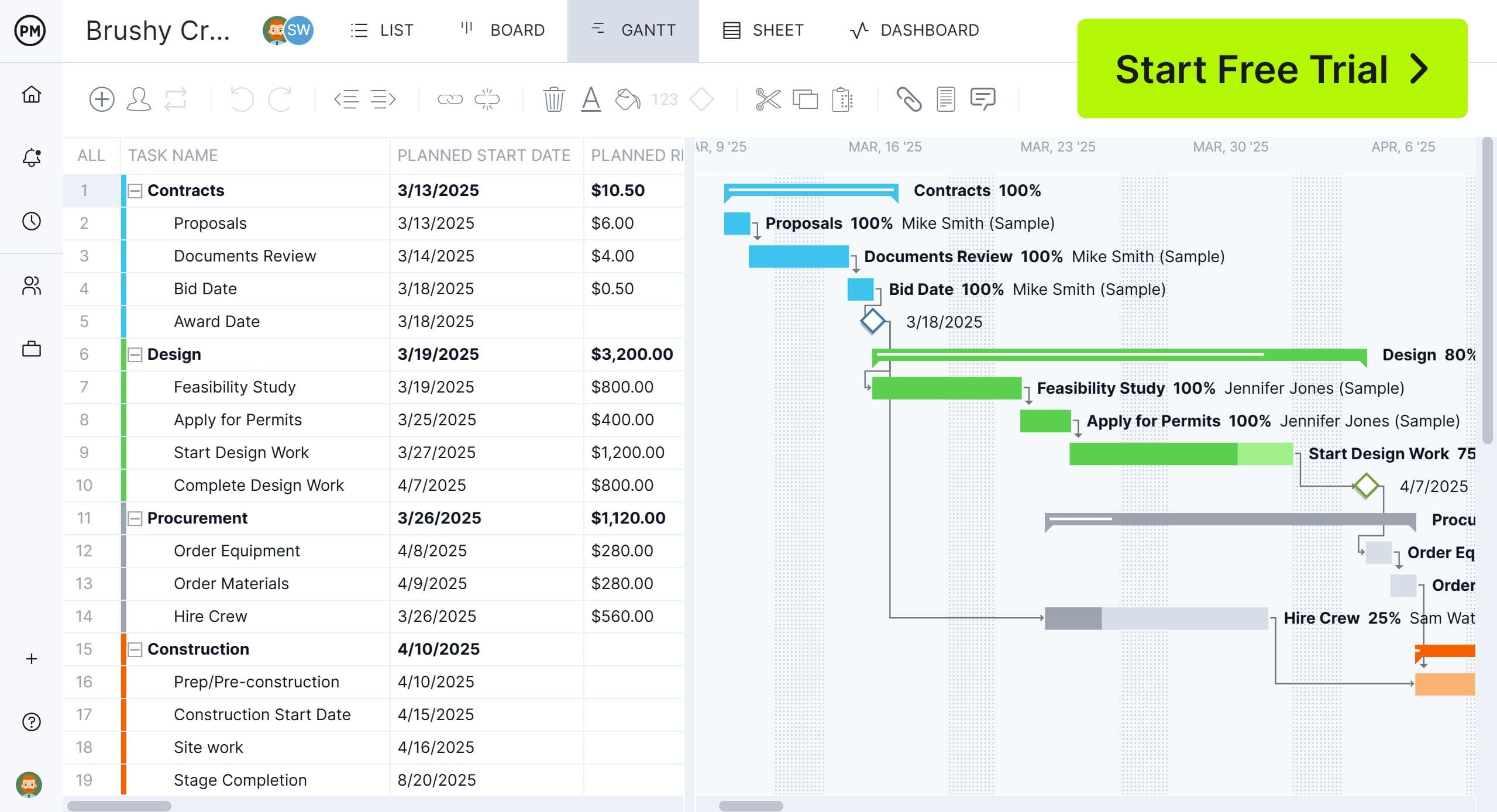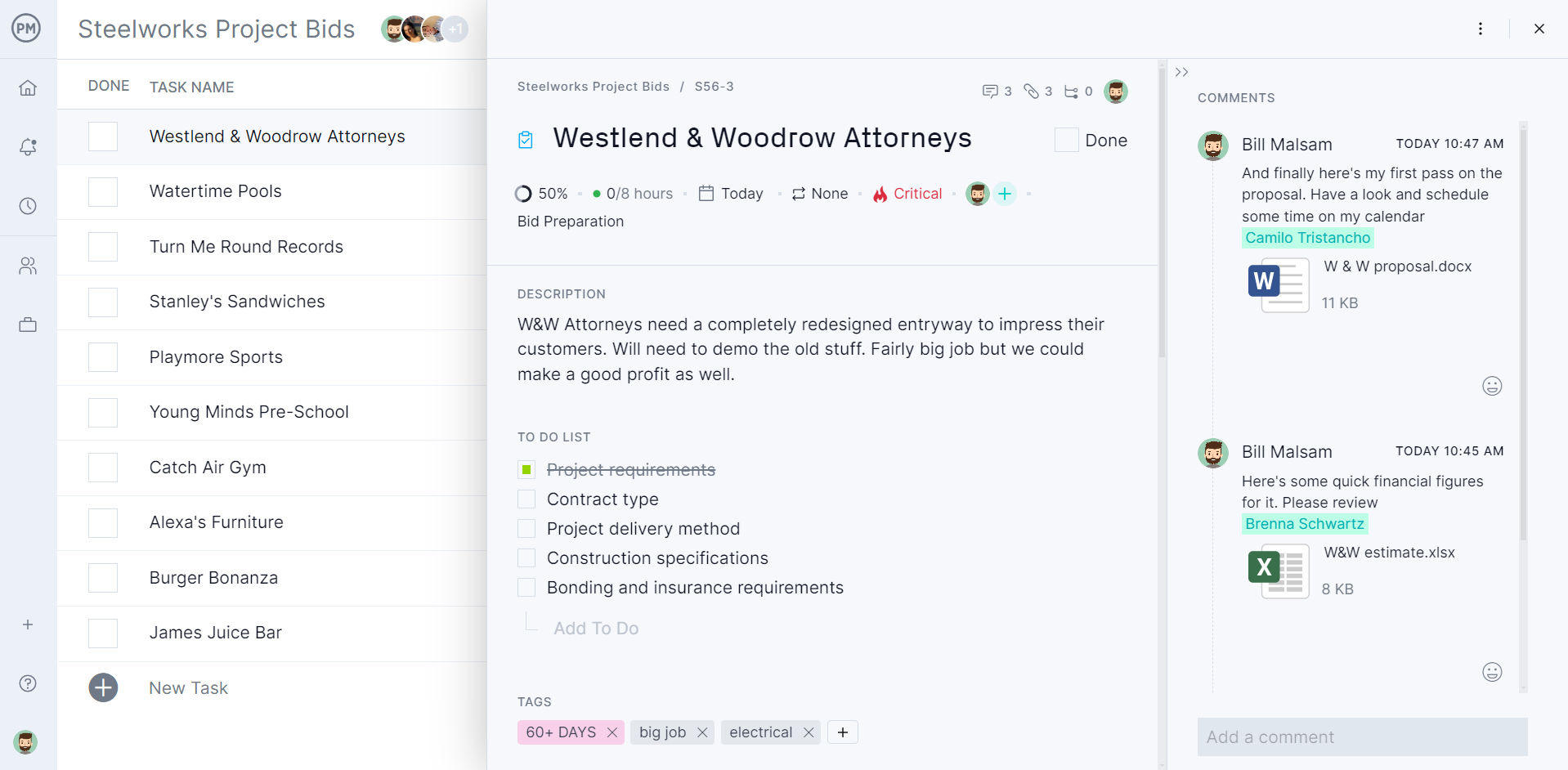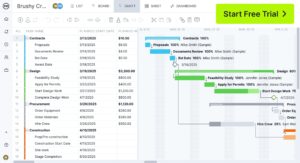Project management examples show how planning, scheduling and execution principles are applied across different industries. They highlight real-world strategies for completing projects on time, staying within budget and achieving the desired outcomes. By examining project management examples from manufacturing, construction, software development and other sectors, teams can learn best practices and adapt them to their own work.
These project management examples also demonstrate how tools and methodologies are used to manage complexity, coordinate resources and communicate progress. Whether it’s a small internal project or a large-scale initiative, seeing how other teams succeed provides inspiration and practical guidance. Below are seven project management examples from across industries that illustrate effective project planning and execution.
Key Elements of These Project Management Examples
These project management examples share several common elements that ensure projects run smoothly and achieve their objectives. From clear goals to well-defined timelines, understanding these key components helps project managers plan, execute and monitor projects effectively. Each element plays a role in minimizing risks, optimizing resources and maintaining stakeholder alignment.
Using project management software makes managing these elements easier and more efficient. Instead of tracking details manually across spreadsheets or documents, software consolidates information, automates calculations and provides real-time visibility. This ensures that project managers can monitor progress, identify bottlenecks and make adjustments quickly without losing control of the project.
ProjectManager is the ideal software for managing project management examples because it combines Gantt charts, multiple project views, dashboards and reporting tools in one platform. Gantt charts allow managers to visualize dependencies, track milestones and set baselines to measure variance. Meanwhile, features like resource management, customizable dashboards and automated reporting make it easy to stay on top of all project elements and deliver projects on time and within budget. Get started with ProjectManager today for free.

Before we get to the examples, here’s a list of the project management elements that can be found in each, regardless of the industry.
- Project Goals and Objectives: Clearly define what the project aims to achieve, providing direction for the team and a benchmark for success.
- Project Scope: Establish the boundaries of the project, specifying what is included and excluded to prevent scope creep.
- Project Deliverables: List the tangible or intangible outputs the project will produce, ensuring expectations are clear for stakeholders.
- Project Resources: Identify the team members, equipment and materials needed, allowing for proper allocation and workload management.
- Project Cost: Plan and monitor the budget to keep expenses under control and make informed financial decisions throughout the project.
- Project Stakeholders: Determine who is impacted or involved, ensuring proper communication and alignment with all parties.
- Project Timeline: Outline the schedule, milestones and deadlines to track progress and maintain accountability for task completion.
- Project Risks: Identify potential issues or obstacles that could impact the project and develop mitigation strategies to minimize their effect.
7 Project Management Examples from Across Industries
Project management examples across industries show how structured planning, execution and monitoring principles can be applied to a variety of contexts. Each industry has unique challenges, from managing resources and timelines to navigating stakeholder expectations and risks. By examining these examples, teams can learn how to adapt best practices and tools to deliver successful outcomes consistently.
While the specific deliverables and resources may vary, these examples share core project management elements: goals and objectives, scope, deliverables, resources, cost, stakeholders, timelines and risk management. Understanding how these elements are applied in real-world projects helps teams identify lessons learned and improve efficiency in their own projects.
1. Construction Project Management Example
In a construction project, the goal might be to build a commercial office building on time and within budget. The project scope includes design, permitting, foundation work, framing, electrical and plumbing systems, finishing and inspections. Deliverables are completed building structures, safety reports and compliance certifications.
Resources include architects, engineers, laborers, heavy equipment and materials. Project costs are monitored through budgets and procurement systems. Stakeholders include investors, contractors, local authorities and tenants. A detailed project timeline is developed using milestones such as foundation completion, structural framing and occupancy permits.
Potential risks include weather delays, labor shortages, supply chain issues and regulatory changes. By managing these elements carefully, construction teams ensure that each phase progresses on schedule, costs are controlled and stakeholders are kept informed, reducing risk and improving overall project success.
2. IT Project Management Example
An IT project may involve developing a new software application for a client. Goals include delivering a functional, scalable and user-friendly system. Scope defines the modules, integrations and platform support included. Deliverables consist of design documents, code repositories, testing results and deployment packages.
Resources include software developers, UX designers, testers and project managers. Project costs cover software licenses, hardware, development hours and testing tools. Stakeholders are clients, internal teams and end-users. The project timeline maps phases from requirements gathering to deployment.
Risks include bugs, missed deadlines, changing client requirements and integration issues. Using these elements, project managers can allocate resources effectively, monitor progress and communicate clearly with stakeholders to ensure a high-quality software product is delivered on time and within budget.
3. Manufacturing Project Management Example
A manufacturing project might focus on launching a new product line. Goals include producing high-quality units at scale while meeting cost and timeline targets. Scope covers product design, prototype development, production planning, quality assurance and distribution. Deliverables include prototypes, production schedules and final products.
Resources include engineers, production staff, raw materials and machinery. Costs are tracked through material, labor and overhead expenses. Stakeholders include suppliers, management, regulatory bodies and customers. The project timeline identifies critical production milestones such as prototype approval, pilot runs and full-scale manufacturing.
Risks involve equipment failure, supply delays, quality issues and workforce shortages. Properly applying project management elements ensures smooth production, cost control and timely delivery, reducing risk while meeting customer expectations.
4. Marketing Project Management Example
A marketing project could involve launching a multi-channel campaign. Project goals focus on brand awareness, lead generation and engagement metrics. Scope defines the channels, messaging and assets included in the campaign. Deliverables include social media content, email campaigns, ad creatives, press releases and analytics reports.
Resources include designers, copywriters, media buyers, project managers and analytics tools. Project costs cover advertising spend, content production and technology subscriptions. Stakeholders include marketing teams, management, clients and external vendors. Timelines outline key milestones such as campaign launch dates, content deadlines and performance reviews.
Risks include missed deadlines, budget overruns, creative misalignment and low engagement. Using these project management elements ensures that marketing campaigns are delivered effectively, resources are optimized and performance is continuously monitored for improvement.
5. Event Project Management Example
In event management, the goal is to deliver a successful conference or public event. The scope includes venue selection, logistics, programming, vendor coordination and attendee management. Deliverables are event schedules, floor plans, promotional materials and feedback reports.
Resources include event coordinators, vendors, speakers, volunteers and equipment. Costs cover venue, catering, marketing and staffing. Stakeholders include attendees, sponsors, vendors and internal teams. The timeline sets deadlines for registrations, setup, rehearsals and the live event.
Risks involve weather, technical failures, scheduling conflicts and safety concerns. Applying project management elements ensures the event runs smoothly, attendees have a positive experience and all logistical and financial objectives are met.
6. Research Project Management Example
For a research project, the goal might be to produce a study that addresses specific scientific questions. The scope covers experimental design, data collection, analysis and publication. Deliverables include research proposals, datasets, reports and peer-reviewed articles.
Resources involve researchers, lab technicians, equipment, software and funding. Project costs are tied to materials, personnel and operational expenses. Stakeholders include academic institutions, funding agencies, collaborators and journal editors. Timelines outline key stages such as proposal submission, data collection, analysis and manuscript submission.
Risks include equipment failure, experimental errors, data inconsistencies and regulatory hurdles. Managing these elements ensures the research is conducted efficiently, results are reliable, and findings are disseminated on schedule.
Related: Best Project Management Software of 2025 (Comparison List)
7. Healthcare Project Management Example
In healthcare, a project might focus on implementing an electronic health record (EHR) system. Goals include improving patient care, data accuracy and regulatory compliance. The scope includes software selection, infrastructure setup, staff training and system integration. Deliverables are functional EHR modules, training manuals and compliance reports.
Resources include IT staff, clinical staff, trainers, hardware and software. Costs cover software licenses, hardware, training and implementation services. Stakeholders are doctors, nurses, administrative staff, patients and regulatory bodies. The timeline includes key milestones such as system design, pilot testing, full deployment and review.
Risks involve data migration errors, staff resistance, downtime and security concerns. Using structured project management ensures the EHR system is implemented efficiently, enhances patient care and meets compliance requirements on time and within budget.
Free Project Management Templates
Free project management templates give teams a structured way to plan, execute and track projects efficiently. They save time, reduce errors and provide a consistent format for documenting project goals, timelines, resources and deliverables. Whether you are managing a small project or a large initiative, these templates help streamline processes and keep everyone aligned.
Project Plan Template for Word
Download this free project plan template for Word to outline your project from start to finish. It includes sections for objectives, scope, milestones, deliverables, resources and risks. Its easy-to-use format is ideal for creating professional project documentation that can be shared with stakeholders, ensuring clear communication and alignment.
Project Plan Template for Excel
Use this free Excel project plan template to track tasks, budgets and timelines in a spreadsheet format. It allows for easy calculations, conditional formatting and visual tracking of project progress. This template is flexible and can be customized to fit projects of any size or complexity, giving managers full control over data organization.
Gantt Chart Template
This free Gantt chart template helps visualize project schedules, task dependencies and deadlines in a clear timeline format. It allows teams to see overlapping tasks, monitor critical paths and track progress against planned milestones. This template is essential for keeping projects on schedule, allocating resources efficiently and ensuring the timely delivery of project goals.
ProjectManager Is Designed for Project Management
ProjectManager is designed to help teams plan, execute and track projects with ease. It consolidates all aspects of project management into one cloud-based platform, giving managers and teams real-time visibility into progress, resources and risks. By centralizing tasks, timelines and communications, ProjectManager eliminates the confusion and inefficiency often caused by juggling multiple spreadsheets or disconnected tools.
Plan and Organize Work Efficiently
With multiple project views including task lists, kanban boards, sheets and calendars, ProjectManager helps managers organize work in the way that suits their team best. Task dependencies, milestones and priorities can be easily set and tracked. This resolves common pain points such as missed deadlines, unclear responsibilities and overlooked tasks. Users can filter and sort tasks, share updates instantly, and ensure every team member knows what needs to be done next.
Track Progress and Optimize Resources
ProjectManager provides real-time dashboards and customizable reports that give detailed insights into task completion, resource utilization and project costs. Baselines can be set to track schedule and budget variance, while workload charts help managers balance assignments and prevent burnout. This solves common challenges like overallocated staff, unexpected delays and uncontrolled costs, allowing teams to make informed decisions, adjust priorities quickly and keep projects on track.
Related Project Management Content
Project management strategy is what separates a successful project from a failed one. This important subject requires more than just a cursory understanding. For those who want to dig deeper into this topic, below are recently published articles on principles of project management, key concepts and more.
- 14 Key Project Management Principles & How to Use Them
- Introduction to Project Management: Key Concepts
- Project Management Basics: Definitions, Methods and Tools
- The 5 Project Management Phases: A Quick Guide
- Importance of Project Management for Organizations
ProjectManager is online project and portfolio management software that connects teams, whether they’re in the office or out in the field. They can share files, comment at the task level and stay updated with email and in-app notifications. Get started with ProjectManager today for free.
The post 7 Project Management Examples from Across Industries appeared first on ProjectManager.








